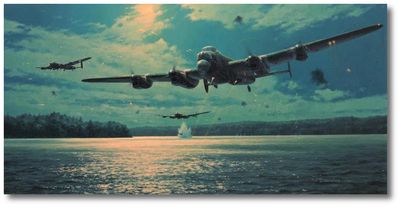
Approach to the Möhne Dam by Anthony Saunders
 |
|
Choose from:
|
 Following three attempts and the tragic loss of one aircraft the dam still held; it is now the turn of Flight Lieutenant David Maltby at the controls of Lancaster AJ-J to press home his attack. With Mick Martin drawing the enemy’s fire to port and Guy Gibson to starboard, Maltby holds his aircraft steady and true as bomb aimer John Fort releases their Upkeep mine.
Following three attempts and the tragic loss of one aircraft the dam still held; it is now the turn of Flight Lieutenant David Maltby at the controls of Lancaster AJ-J to press home his attack. With Mick Martin drawing the enemy’s fire to port and Guy Gibson to starboard, Maltby holds his aircraft steady and true as bomb aimer John Fort releases their Upkeep mine.The time was 00.49 hrs on the morning of 17 May 1943 and the mine bounced to perfection, hit the target, sank, and detonated against the already damaged stone wall. Immeasurable pressure forced water through the groaning, already cracking blocks of granite until the dam could stand no more. The wall shuddered and then surrendered. ‘There was a breach 100yds across,’ Gibson wrote later, ‘and the water, looking like stirred porridge in the moonlight, was gushing out and rolling into the Ruhr valley....’
We're honored that this special release, commemorating the 75th Anniversary, has been personally signed by veterans who helped create the Dambusters legend. This fitting tribute to one of the most famous missions in the history of aerial warfare creates a historic collector’s item for aviation art enthusiasts and history buffs alike.
Signatures:
With the threat from Hitler’s increasingly belligerent regime growing, minds within Britain’s Air Ministry had already identified potential targets should the unthinkable happen and war with Germany become a reality. The list included the great dams of western Germany, some of the largest in the world.
On 9 September 1939 Hitler’s armies invaded Poland and, as Britain once again found herself at war with Germany, plans to attack the dams became a reality. Three were chosen as primary targets; the Möhne, Eder and Sorpe dams which between them controlled the vast supplies of water to the factories and manufacturing industries of the Ruhr. If these dams could be destroyed, the beating heart of industrial Germany would be dealt a heavy blow.
But there were problems; the range and dam defences were too great for a low-level attack by existing aircraft and commando raids were thought suicidal, with little chance of success. Barnes Wallis, however, had an idea – a cylindrical ‘bouncing bomb’ codenamed Upkeep – a mine designed to skip across the surface of the water clearing the torpedo nets, and explode against a dam wall at a depth that would cause maximum destruction.
To deliver his weapon, however, would require men of extraordinary flying skills, and an aircraft big enough for the job. By March 1943 all the criteria had been met; Upkeep was ready and tested, a new special squadron numbered 617 had been formed under Wing Commander Guy Gibson, and Avro’s mighty Lancaster bomber was up to the task. On the evening of 16 May 1943, after weeks of intensive training, Gibson led the first wave of bombers away from RAF Scampton and set course for the Moehne dam. The Dambuster raid had begun.
Anthony Saunders’ painting, Approach to the Möhne Dam, already hailed as a masterpiece of aviation art and one of the most authentic interpretations of events yet created, captures the moment when the fate of the Mohne dam was sealed.














